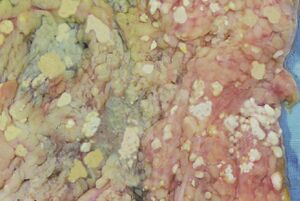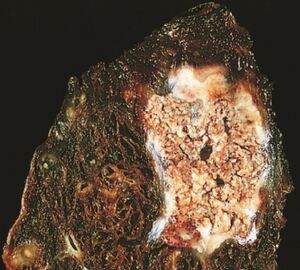6. Caseous necrosis and adiponecrosis
Adiponecrosis

Also called fat necrosis, adiponecrosis is a necrosis of adipose tissue, often caused by release of activated pancreatic lipases into the pancreas and peritoneal cavity. The lipases digest the cell membranes of adipocytes and then split the triacylglycerols into free fatty acids. The free fatty acids then combine with calcium ions to produce chalky white areas, a process called saponification (= soap formation, the same process produces normal soap). Adiponecrosis usually happens as a consequence of acute pancreatitis.
Caseous necrosis

Caseous necrosis is characteristic for tuberculosis, a lung infection usually caused by mycobacterium tuberculosis. The immune reaction caused by m. tuberculosis is a special one, called the hypersensitivity type 4 or delayed-type hypersensitivity reaction, which makes this type of necrosis special. The word caseous means cheese-like, owing to the yellow-white, crumbly macroscopic characteristics of this type of necrosis.
With light microscopy we can see granulomas, a special type of inflammation we’ll learn more about in the inflammation topics.
